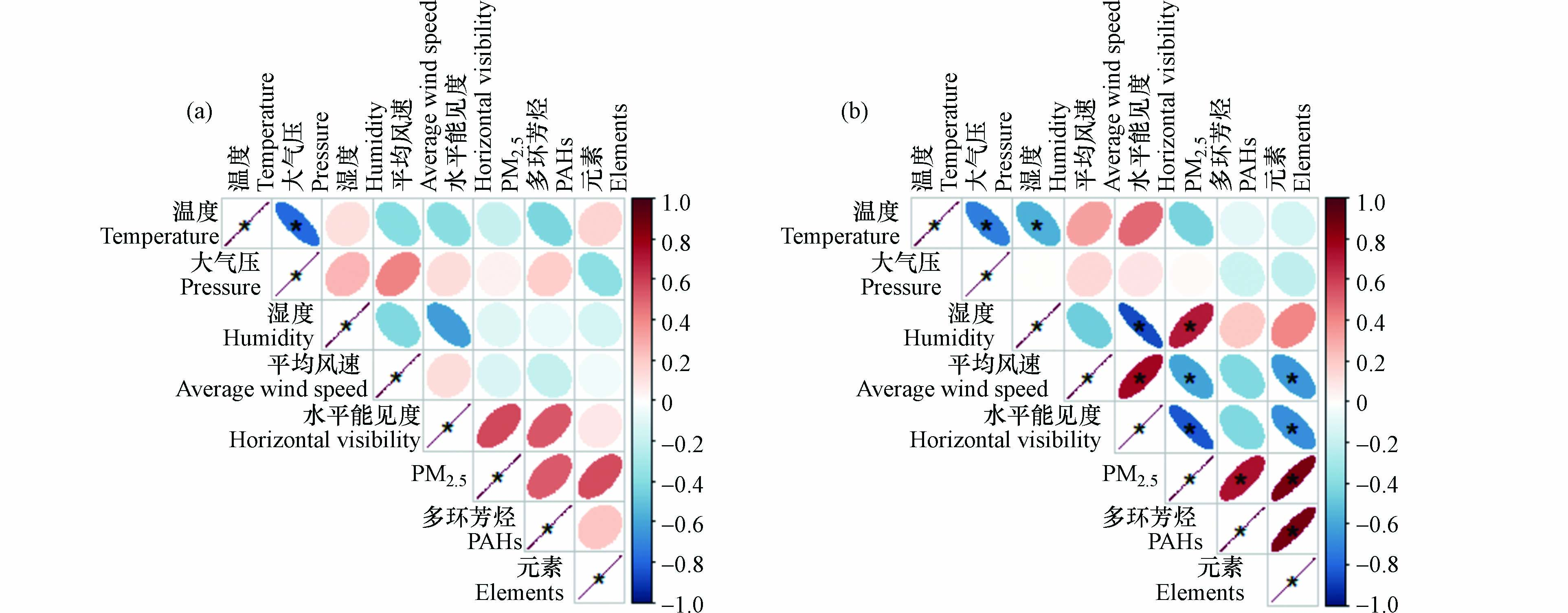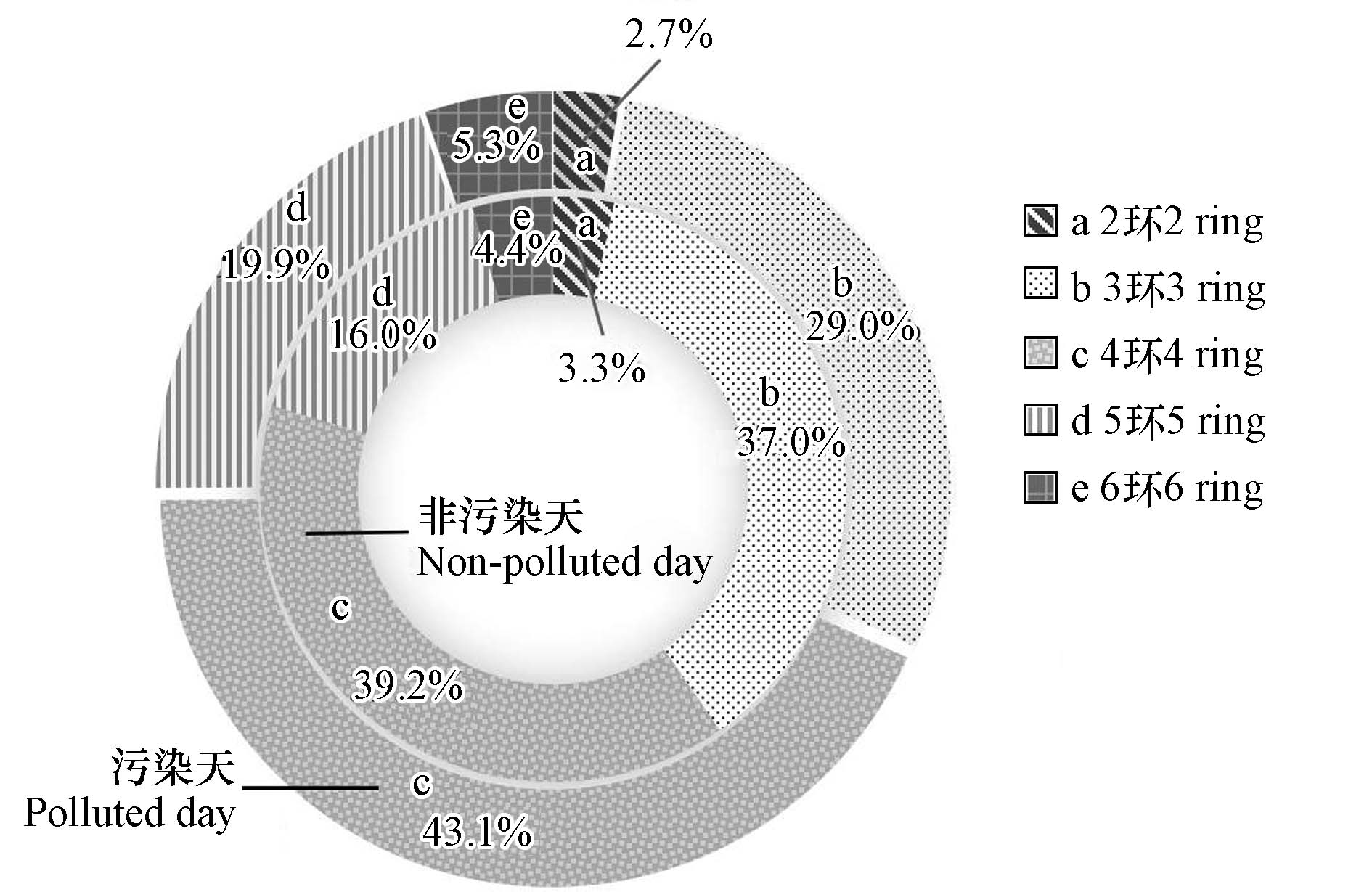-
大气细颗粒物(PM2.5)因近几十年社会发展形势的快速更替,已成为现今主要的大气污染物,对气候、经济和人群健康产生影响[1]。据世界银行统计,我国2013年因PM2.5污染带来的经济损失约为1.6万亿美元[2],PM2.5污染导致全球每年330万人过早死亡[3],现已有许多新技术和新材料应用于空气污染控制,以最大限度地减少PM2.5污染对健康的影响,但PM2.5污染防治仍是一个亟需解决的难题。
对人群健康造成危害的主要因素实则是PM2.5携带的有机物和无机元素等物质。其中,多环芳烃(polycyclic aromatic hydrocarbons,PAHs)是结构中含有两个或两个以上苯环的碳氢化合物,是化石燃料燃烧、工业及汽车排放的产物之一[4]。国内外许多研究揭示了多种PAHs组分,如苯并[a]芘、茚并[1,2,3-c,d]芘和二苯并[a,h]蒽具有致癌、致畸和致突变性[5],且高浓度PAHs暴露与癌症的发生密切相关[6],其中四环以上PAHs可长期附着于在颗粒物[7],随呼吸进入人体肺部,增加患肺癌风险[8]。美国EPA于1976年将16种PAHs列为优控污染物[9],我国《环境空气质量标准》(GB 3095—2012)[10]仅规定了BaP的日均浓度限值(2.5 ng·m−3)。前期研究表明,由于燃煤取暖,导致冬季PM2.5中PAHs含量远高于其他季节,国内外皆是如此[11-12],因此对人体健康造成更高风险[13-14]。颗粒物吸附的元素主要来源于人为活动影响下的工业生产和尾气排放,导致大气中元素浓度远高于自然本底值[15],与粗颗粒物(PM10)相比,元素组分更集中在PM2.5上[16],甚至成为PM2.5的主要组成。部分元素如镉、镍、铅、锰等具有生物毒性,可通过呼吸道进入人体,因无法降解而长期积累,导致中毒、贫血、肺细胞损伤、神经毒性等疾病[17-18]。既往研究证实,大气颗粒物长期暴露是导致人体血液和尿液中元素超标的重要因素[19]。因此,大气颗粒物中PAHs和元素组分逐渐成为重点研究和管控对象。
济南市地处山东省中部,地势南高北低,属温带半湿润季风气候,化工产业在全市经济生产总值中占较大比重,经济、能源、交通的快速发展和人口的膨胀,使济南成为全国大气污染较为严重的城市之一[20]。济南市PM2.5的既往相关研究着重于讨论采暖季与非采暖季的特征差异[21-23],关于采暖季不同污染天气的PM2.5特征研究还较少,鉴于此,本研究通过采集济南市采暖季大气PM2.5样品,分析其上16种PAHs和12种元素组分的含量,探讨采暖季不同污染天气的颗粒物特征及来源,为济南市大气污染防治措施的制定实施提供参考依据。
-
本研究采样点位于济南市历下区某社区医院五楼楼顶,距地面约15—18 m。距市政府直线4.7 km,周围以居民区和商业区为主。附近有两条主干道,分别是距正东方向566 m的二环高架路和向北1400 m的解放路。PM2.5采集流量100 L·min−1,单次采样时间约24 h,从早上8:00开始至次日早上8:00,从2018年12月到2019年1月,共采集PM2.5样本23份。将当天采集的空气滤膜样本及时从采集器取出,放置在滤膜盒中密封标记,保存在-20 ℃冰箱,以避免化学分析前有机物的蒸发。采样期间气象数据从国家气象信息中心获取。
-
本研究使用的仪器包括:Nexl0N 300x电感耦合等离子体质谱仪(美国珀金埃尔默公司),6890-5973N气相色谱质谱联用仪(美国安捷伦公司),MARS-6-240/50微波消解仪(美国培安公司),EHD-24赶酸仪(东方科创生物技术有限公司),恒温恒湿箱(德国宾德公司),XSl05DU型天平(瑞士梅特勒公司),TH-150C型中流量颗粒物采样器(武汉天虹仪表有限责任公司),90 mm滤膜(美国Pall公司)。
试剂:16种PAHs(萘Nap、苊Acy、苊烯Ace、芴Fl、菲Phe、蒽Ant、荧蒽Flu、芘Pyr、苯并[a]蒽BaA、䓛Chr、苯并[b+j+k]荧蒽B[b+j+k]F、苯并[a]芘BaP、苯并[e]芘BeP、茚并[123-cd]芘InP、二苯并[a,h]蒽DBA、苯并[g,h,i]苝BghiP)混标和5种PAHs氘代内标(萘-d8、苊-d10、菲-d10、䓛-d12、芘-d12(美国o2si公司),12种元素混标(铝Al、铬Cr、铁Fe、砷As、铊Tl、铅Pb、铋Bi、钾K、硒Se、铀U、镉Cd、锰Mn)(美国珀金埃尔默公司),浓硝酸(优级纯,德国默克公司),盐酸(优级纯,韩国DUKSAN公司),氢氟酸(MOS级,国药集团化学试剂有限公司)。
-
PM2.5浓度由采样前后的质量差得到。采样前将空白滤膜放置恒温恒湿箱中平衡24 h(温度(25±1)℃,湿度50%±5%),再在相同温湿度的天平室称重两次,间隔1 h,取两次平均值为空白滤膜质量。在相同条件下,得到采样后滤膜质量,二者之差即为滤膜上采集到的PM2.5质量。
测定元素:参照文献[24],取1/8滤膜样品加入硝酸、氢氟酸和盐酸混合体系中,微波消解仪消解,赶酸仪赶酸后,用ICP-MS测定元素浓度。检测时用不同浓度空白滤膜溶液做工作曲线,使用Re内标校准信号漂移。
测定PAHs:取1/4滤膜作碎化处理后,用正己烷超声提取,提取液经离心后取上清液待测,用GC/MS测定PM2.5中PAHs,具体操作参见已发表文献[25]。
-
采用SPSS Statistics 25.0进行数据分析,RStudio和Origin 2018做图。数据使用均值±标准差进行描述。参照国家标准[10],将采样期间日均PM2.5浓度低于75 μg·m−3的划分为非污染天,高于75 μg·m−3的划分为污染天。PM2.5与其负载的组分浓度相关性采用Spearman分析(双侧检验,置信区间CI:95%),P<0.05认为具有显著性。
-
为探究气象条件对大气PM2.5及其组分浓度的影响,本研究统计分析采样期间济南市PM2.5浓度与气象因素(温度、大气压、相对湿度、平均风速以及水平能见度)的相关关系(图1)。
图1为采样期间非污染天和污染天气象因素与日均PM2.5浓度、PAHs总量和元素总量间的相关性。污染天温度和大气压与污染物浓度变化趋势相反,可能是低温、高压抑制污染物的扩散[26]。相对湿度、平均风速和水平能见度3个因素对PM2.5及其组分的影响较为显著,其中相对湿度的影响呈正相关(P<0.01),结果与孙凤娟等[20]2014年1月和黄善斌等[26] 2013—2018年对济南市的研究结果相同,冬、秋季室外PM2.5浓度与相对湿度呈正相关。通常室外湿度越大(降雨)PM2.5浓度越低,降雨将空气中颗粒物冲刷至地面,大气污染得到短时间改善[26]。但无降水时,室外相对湿度却为PM2.5及空气中其他细小颗粒物的吸湿聚集提供了良好条件,不仅增加颗粒物间的黏结性,同时导致空气流动缓慢,阻碍污染物扩散[27]。此外,本研究非污染天的相对湿度在21%—44%之间,污染天相对湿度为32%—78%,且PM2.5浓度>150 μg·m−3的重污染天气多发生在相对湿度为55%—78%。徐杰等[28]对常州市2015—2016年PM2.5浓度及相对湿度的统计发现,PM2.5浓度高于75 μg·m−3的污染天气其相对湿度主要在60%—80%之间,与本研究高度相似,由此证明大气高湿度对PM2.5污染有加重趋势。而非污染天气象因素与PM2.5及其组分的相关性不显著,相对湿度对PM2.5及其组分浓度都具有反作用。两种天气下风速对污染物都具有抑制作用,污染天气更明显(r=-0.58,P<0.05),风速越大,对PM2.5的远距离扩散越有利,污染物的区域性浓度越小,与唐山市2017年[29]和西安市2018年[14]采暖季研究结果相同。污染天的室外水平能见度与大气污染物间显著负相关(r=-0.85,P<0.05),非污染天完全相反。可能是因为PM2.5近年来已成为影响市区道路能见度的主要诱因[30],故PM2.5浓度越大,大气污染越严重,室外能见度越低,交通事故发生率也相应增加。此外,污染天PM2.5浓度与其负载的PAHs和元素总量间具有显著正相关关系。
-
研究期间PM2.5及其负载PAHs和元素组分在不同污染天气的浓度如表1所示。采样期间PM2.5平均浓度为105.62 μg·m−3,2016年[31]、2017年[21]同期浓度为103.25 μg·m−3和85.32 μg·m−3,相比之下,本研究采样期间大气污染更严重。污染发生过程中大气PM2.5浓度是非污染天的3.78倍,不同污染天气PM2.5浓度具有统计学差异(P=0.007)。相同时期内,太原市灰霾天PM2.5浓度为优良天的5.76倍[32],西安市重污染天平均浓度为191.49 μg·m−3[33]。污染天占采样总天数的56.53%,期间PM2.5浓度为《环境空气质量标准》(GB 3095—2012)[10]中二级限值的2.07倍,PAHs浓度总量是非污染天的1.52倍,元素为1.51倍,浓度低于北京市[25]和西安市[14]。
据采样期间气象数据统计推测,污染天气的发生可能主要与其主导风向密切相关。济南市2018年12月—2019年1月大部分时间盛行东风及东南风,但在污染发生天气主要盛行西北风且为灰霾天气,这极有可能是因为济南市位于石家庄市东北部,石家庄大气污染状况较为严重且位于我国城市空气污染前列,西北风将大部分颗粒物及沙尘迁移至济南方向。
-
研究期间不同污染天气状况下PM2.5中16种PAHs质量浓度如图2所示,非污染天和污染天PM2.5中PAHs总量范围分别为3.12—46.57 ng·m−3 和19.05—89.22 ng·m−3,低于西安市2018年[14]和太原市2016年[34]采暖季PM2.5中PAHs浓度。污染天PAHs总量均值是非污染天的1.52倍,16种PAHs浓度在两种天气污染状况的分布趋势基本一致,污染天各组分浓度超过非污染天浓度的3.87%—101.4%,与刘艳菊等对北京重污染天气的研究结果一致[35],说明污染天高浓度PM2.5吸附了更多的PAHs。
由于采样期间不同污染天PM2.5浓度差异较大,其负载的PAHs组分构成比也发生了些许变化(图2),非污染天PAHs浓度前五位为An>BaA>Flu>Pyr>Chr,污染天为BaA>An>Chr = Flu>Pyr。污染天气发生过程中,BaA 浓度最高,且Chr的浓度升高最显著。可能是因为BaA主要存在于煤焦油和汽车排气中,Chr是煤焦油及烟雾的主要成分,因而随燃煤量的上升浓度增加较快[36]。此外,污染天BaP浓度均值为2.95 ng·m−3,已超过我国规定值,提示可能会对人群健康产生危害[10]。
为验证上述研究结果,对不同污染条件下PM2.5及其PAHs浓度做相关分析,两种不同污染条件之间存在较大差异。非污染天两者相关性为0.519且不显著,而污染天为0.736,且P<0.01呈显著正相关。因此,PM2.5中PAHs浓度可能随天气污染程度的加重而加倍富集。有研究表明相较PM10,PAHs更易附着于PM2.5 [35],故加强对PM2.5的防控至关重要。
-
本研究中,相比PAHs,元素在PM2.5中占有更高的比重,也是采暖季大气颗粒物的重要组成。图3为各元素在采样期间不同污染天气的浓度柱形图。
由图3可知,PM2.5中元素随污染程度加剧而总体呈上升趋势,污染天(范围:1730.59—3611.6 ng·m−3,平均:2615.98 ng·m−3)显著高于非污染天(229.38—2529.17 ng·m−3,平均:1749.36 ng·m−3),且高于2014年贵阳、成都[37]和2016年北京怀柔区[38]污染天浓度。12种元素浓度在两种天气状况的分布趋势基本一致,污染天各元素浓度超过非污染天浓度的34%—152%,元素总量是非污染天的1.99倍。统计发现,两种天气下元素浓度构成比最大的前3位分别是Al、K和Fe,均属于地壳元素,推测可能与污染期间的地表扬尘有关[39]。与王鑫等[33]研究结果相同,污染前后其余金属元素构成比情况没有发生变化。此外,污染天气多发生在2019年1月,且K元素升高的原因可能在于此时在小年前夕,可能与工厂加快生产及烟花售卖燃放等活动有关[40]。
采样期间大气PM2.5及其元素总量的相关性分析结果显示,非污染天两者相关性较弱且不显著,但污染天却表现出极强的线性相关性,r=0.85779,P<0.001,由此可见,PM2.5中元素总量与大气污染的严重程度密切相关。
-
PM2.5的来源解析通常可通过分析其所含化学组分来源判断,本研究运用简易比值法对PM2.5中PAHs和元素的来源进行了初步分析。
按照PAHs各组分结构中包含的苯环数目可将其划分为二环、三环、四环、五环和六环,分别统计不同环数PAHs组分在济南市采暖季不同污染天气状况下的所占百分比。二环包括Nap、Acy和Fl,三环包括Ace、Phe、An和Flu,四环包括Pyr、BaA、Chr和苯并[b+j+k]荧蒽,五环包括BeP、BaP、InP、DBA,六环仅有BghiP[41]。如图4所示,由非污染天转为污染天过程中,三环含量下降,四环及以上含量上升,其中四环浓度最高,与刘艳菊等[35]、蔡瑞婷等[14]结果一致。有研究表明,四环PAHs大多来源于煤炭等化石燃料的燃烧,五环六环主要与汽油柴油有关[42],因此本研究PM2.5中PAHs的主要来源为煤炭及交通排放。因二环三环PAHs分子量较小,较易挥发,在大气中多存在于气相中,而四环PAHs沸点较高,不易挥发,常温下以气态状和颗粒物状两种形式存在,五环六环PAHs最稳定,多附着在颗粒物上[43]。此外,本研究还运用特征比值法对上述结果进行验证,如表2所示,参照以往类似研究中的7种PAHs比值,根据其相应的数值范围来判别济南市采暖季大气PM2.5中PAHs主要来源。结果发现,非污染天和污染天比值结果非常接近,PAHs主要来源集中在燃煤和机动车油品排放,与李岩岩在2018年济南冬季开展的研究结论相同[44]。因此推测,污染天PM2.5及其负载元素组分虽较非污染天显著上升,但大气PM2.5中PAHs来源构成没有发生变化。
表3为济南市采暖季大气PM2.5中元素富集因子系数,按照EF值大小,将其划分为4个富集程度:EF<1轻度富集,1≤EF<10中度富集,10≤EF<100高度富集,EF≥100极高富集[52]。依据既往研究,当EF>10时,表明该元素的富集是受到人为活动的影响;EF≤1时,该元素来源于天然尘埃;1≤EF<10时,两种污染源均有贡献。当EF<5时,一般认为该元素主要来源于地壳或土壤[53]。由于Al元素性质稳定,常被选用为参考元素,故参照TAYLOR等[54]研究结果中的各元素地壳浓度值,以Al为参考元素,计算PM2.5中元素富集因子。结果显示,济南市各元素富集程度和污染来源在非污染天和污染天差异较小,As、Pb、Bi和Cd为极高富集元素,Cr、Tl和Ni为高度富集元素,与李星谕等[55]黄冈市灰霾期和王鑫等[33]西安市重污染天气结果一致,这些元素的共同特点是具有生物毒性,对人群健康会产生巨大的健康危害。此外,Tl、Cr是燃煤的特征元素,Bi是工业源的典型元素,Pb是汽车尾气的重要标志物,Cd主要源于燃煤和交通,Ni是化石燃料的产物[56],故而本研究PM2.5中元素的来源受人为影响较大,主要是燃煤和汽车尾气,与济南市既往研究结果相同[43]。
综上,通过PAHs环数占比、特征比值法和元素富集因子3种方式进行污染源初步解析,结果皆指向相同来源,即主要是煤炭燃烧和交通尾气排放,济南地区冬季可针对此两方面出台相应的控制措施,来削减其对大气污染的贡献,如北京市2017年严格实施淘汰小型燃煤锅炉和报废旧汽车等措施后,当年采暖季PM2.5浓度较上年降低近一半[57],可见因地制宜开展大气防治对降低空气污染的高效性。
-
本研究对济南市2018年采暖期不同污染天气下的PM2.5及其负载组分的浓度和特征分布进行了研究,结果表明污染天PM2.5平均浓度已达到我国重度污染标准,且与大气相对湿度显著正相关,说明除污染源排放外,低风速,高湿度且地面逆温的气象条件是造成空气重污染的主要外部因素;本研究发现污染天PM2.5中PAHs和元素浓度是非污染天的1.5倍,且与PM2.5浓度正相关,提示重污染天气对人群健康危害更严重,需要加强重污染天气预警提示民众加强防护,同时采取相应的措施减少污染物排放。研究通过不同方式的污染源初步解析结果提示,济南市采暖期大气PM2.5主要来源是燃煤取暖和机动车尾气排放,说明落实节能减排,适当调整城市能源结构,将有助于改善采暖季大气环境质量。
济南市采暖季不同污染天气PM2.5及其PAHs和元素组分污染特征及源解析
Characterization and source analysis of PM2.5 and its PAHs and element components in different polluted weather in Jinan heating season
-
摘要: 我国近年大气污染治理虽取得一定成效,但冬季采暖期仍是大气重污染频发时期。为探究济南市采暖季不同污染天气PM2.5及其负载组分的污染特征及来源,采集2018年12月—2019年1月济南市中心某社区室外大气PM2.5样本,用重量法计算PM2.5浓度,GC/MS检测PAHs浓度,ICP-MS检测元素组分。发现济南市采暖季污染天PM2.5浓度与室外相对湿度呈显著正相关(r=0.7968,P<0.05);污染天PM2.5浓度显著高于非污染天,其负载的PAHs和元素浓度均随PM2.5的升高而升高,两种天气下PAHs环数占比、特征比值法和元素富集因子法得到的源解析结果接近。提示污染天PM2.5虽显著升高,但PM2.5中PAHs和元素均主要来自煤炭燃烧和尾气排放,污染源类型的构成却没有发生明显改变。Abstract: Although some remarkable progress has been achieved in air pollution control in China in recent years, winter heating season is still a period of most concern due to its frequent air pollution. In order to explore the pollution characteristics and sources of PM2.5 and its load components in different polluted period during the heating season in Jinan, atmospheric PM2.5 were collected in an urban community of Jinan from December 2018 to January 2019. PM2.5 was measured by gravimetric method and PAHs and elements were analyzed by GC/MS and ICP-MS separately. It was found that there was significantly positive relation between PM2.5 and atmospheric relative humidity during the heating season (r=0.7968, P<0.05),and the concentration of PM2.5 in polluted period was significantly higher than that in non-polluted period, and the PAHs and element concentrations accumulated with the increase of PM2.5. The source analysis through the ratio of PAHs cycle number, characteristic ratio and element enrichment factor indicated the similar source in the two weather conditions, suggesting that although PM2.5 increased significantly on polluted days, the PAHs and elements in PM2.5 mainly came from the consistent coal combustion and exhaust emissions, and the composition of pollution sources had not changed significantly.
-
Key words:
- PM2.5 /
- PAHs /
- elements /
- source analysis.
-

-
表 1 采样期间大气PM2.5及其负载组分浓度水平
Table 1. The concentration of PM2.5 and its load components during the sampling period
分组
Groupn PM2.5/(μg·m−3) PAHs总量/(ng·m−3)
Total concentration of PAHs元素总量/(ng·m−3)
Total concentration of elements非污染天 10 40.97±21.94 28.17±21.48 1784.2±654.03 污染天 13 155.35±75.81 42.79±20.11 2691.8±561.81 合计 23 105.62±81.81 36.44±21.54 2297.2±747.54 表 2 不同污染条件下PM2.5中PAHs特征比值
Table 2. Characteristic ratio of PAHs in PM2.5 in different polluted period
特征比值
Diagnostic ratios参考范围
Reference range主要来源
Main source非污染天
Non-polluted day污染天
Polluted day参考文献
ReferencesBaA/(BaA+Chr) <0.2 成岩 0.632 0.567 [45] 0.2 — 0.35 燃煤 [46] >0.35 机动车 Bap/BghiP 0.9 — 6.6 燃煤 1.181 1.241 [45] 0.3 — 0.4 柴油 0.5 — 0.6 汽油 Pyr/Bap <1 燃煤 1.642 1.561 [47] 1 — 6 汽油 Bap/(Bap+Chr) 0.07—0.24 燃煤 0.546 0.421 [48] 0.49 汽油 0.68 柴油 An/(An+Phe) 0.5 汽油 0.626 0.629 [45] 0.35 柴油 <0.1 化石燃料未完全燃烧 [49] Flu/(Flu+Pyr) <0.5 汽油 0.536 0.528 [45] >0.5 柴油 [50] 0.53 燃煤/烹饪 [45] InP/(InP+BghiP) <0.2 汽油 0.478 0.485 [51] 0.35—0.7 柴油 [45] 表 3 不同污染条件下PM2.5中元素富集因子
Table 3. Metal enrichment factors in PM2.5 in different polluted period
元素
Elements非污染天Non-polluted day 污染天Polluted day EF 富集程度
Degree of enrichment污染来源
Source of pollutionEF 富集程度
Degree of enrichment污染来源
Source of pollutionCr 26.7 高度富集 人为源 38.67 高度富集 人为源 >Fe >1.01 >中度富集 >地壳或土壤 >1.45 >中度富集 >地壳或土壤 >As >526.33 >极高富集 >人为源 >797.87 >极高富集 >人为源 >Tl >54.52 >高度富集 >人为源 >73.33 >高度富集 >人为源 >Pb >177.23 >极高富集 >人为源 >254.01 >极高富集 >人为源 >Bi >730.07 >极高富集 >人为源 >1604.56 >极高富集 >人为源 >K >1.69 >中度富集 >地壳或土壤 >4.28 >中度富集 >地壳或土壤 >Se >8.31 >中度富集 >天然和人为源 >4.22 >中度富集 >地壳或土壤 >U >4.41 >中度富集 >地壳或土壤 >8.47 >中度富集 >天然和人为源 >Ni >55.04 >高度富集 >人为源 >61.34 >高度富集 >人为源 >Cd >840.03 >极高富集 >人为源 >1925.09 >极高富集 >人为源 Mn 3.33 中度富集 地壳或土壤 6.77 中度富集 天然和人为源 -
[1] 朱来东, 王兴峰, 王长征, 等. 浅谈PM2.5的环境影响评价 [J]. 甘肃冶金, 2013, 35(4): 94-96. ZHU L D, WANG X F, WANG C Z, et al. Discussion of PM2.5 in environmental impact assessment [J]. Gansu Metallurgy, 2013, 35(4): 94-96(in Chinese).
[2] BANK W. Institute for health metrics and evaluation. The cost of air pollution: strengthening the economic case for action[M]. Washington, DC: World Bank, 2016. [3] LELIEVELD J, EVANS J S, FNAIS M, et al. The contribution of outdoor air pollution sources to premature mortality on a global scale [J]. Nature, 2015, 525(7569): 367-371. doi: 10.1038/nature15371 [4] LI H Y, LAI Z N, ZENG Y Y, et al. Occurrence, source identification, and ecological risk assessment of polycyclic aromatic hydrocarbons in sediments of the Pearl River Delta, China [J]. Marine Pollution Bulletin, 2021, 170: 112666. doi: 10.1016/j.marpolbul.2021.112666 [5] AAMIR M, YIN S S, LIU Y X, et al. Dietary exposure and cancer risk assessment of the Pakistani population exposed to polycyclic aromatic hydrocarbons [J]. Science of the Total Environment, 2021, 757: 143828. doi: 10.1016/j.scitotenv.2020.143828 [6] STADING R, GASTELUM G, CHU C, et al. Molecular mechanisms of pulmonary carcinogenesis by polycyclic aromatic hydrocarbons (PAHs): Implications for human lung cancer [J]. Seminars in Cancer Biology, 2021, 76: 3-16. doi: 10.1016/j.semcancer.2021.07.001 [7] JAMHARI A A, SAHANI M, LATIF M T, et al. Concentration and source identification of polycyclic aromatic hydrocarbons (PAHs) in PM10 of urban, industrial and semi-urban areas in Malaysia [J]. Atmospheric Environment, 2014, 86: 16-27. doi: 10.1016/j.atmosenv.2013.12.019 [8] SARIGIANNIS D Α, KARAKITSIOS S P, ZIKOPOULOS D, et al. Lung cancer risk from PAHs emitted from biomass combustion [J]. Environmental Research, 2015, 137: 147-156. doi: 10.1016/j.envres.2014.12.009 [9] LI J, ZHANG G, LI X D, et al. Source seasonality of polycyclic aromatic hydrocarbons (PAHs) in a subtropical city, Guangzhou, South China [J]. Science of the Total Environment, 2006, 355(1/2/3): 145-155. [10] 国家环境保护局. 环境空气质量标准: GB 3095—1996[S]. 北京: 中国标准出版社, 2012. State Bureau of Environmental Protection of the People's Republic of China. Ambient air quality standard: GB 3095—1996[S]. Beijing: Standards Press of China, 2012 (in Chinese).
[11] JIANG Y L, HOU X M, ZHUANG G S, et al. The sources and seasonal variations of organic compounds in PM2.5 in Beijing and Shanghai [J]. Journal of Atmospheric Chemistry, 2009, 62(3): 175-192. doi: 10.1007/s10874-010-9147-0 [12] TEIXEIRA E C, MATTIUZI C D P, AGUDELO-CASTAÑEDA D M, et al. Polycyclic aromatic hydrocarbons study in atmospheric fine and coarse particles using diagnostic ratios and receptor model in urban/industrial region [J]. Environmental Monitoring and Assessment, 2013, 185(11): 9587-9602. doi: 10.1007/s10661-013-3276-2 [13] XIA Z H, DUAN X L, TAO S, et al. Pollution level, inhalation exposure and lung cancer risk of ambient atmospheric polycyclic aromatic hydrocarbons (PAHs) in Taiyuan, China [J]. Environmental Pollution, 2013, 173: 150-156. doi: 10.1016/j.envpol.2012.10.009 [14] 蔡瑞婷, 肖舜, 董治宝, 等. 汾渭平原典型城乡PM2.5中多环芳烃特征与健康风险 [J]. 地理学报, 2021, 76(3): 740-752. CAI R T, XIAO S, DONG Z B, et al. Characteristics and health risk of polycyclic aromatic hydrocarbons in PM2.5 in the typical urban and rural areas of the Fenwei Plain [J]. Acta Geographica Sinica, 2021, 76(3): 740-752(in Chinese).
[15] CHARLESWORTH S, de MIGUEL E, ORDÓÑEZ A. A review of the distribution of particulate trace elements in urban terrestrial environments and its application to considerations of risk [J]. Environmental Geochemistry and Health, 2011, 33(2): 103-123. doi: 10.1007/s10653-010-9325-7 [16] 闫丽娜, 左昊, 张聚全, 等. 石家庄市大气PM1、PM2.5和PM10中重金属元素分布特征及来源的对比研究 [J]. 地学前缘, 2019, 26(3): 263-270. YAN L N, ZUO H, ZHANG J Q, et al. Comparative study on the distribution characteristics and sources of heavy metal elements in PM1, PM2.5 and PM10 in Shijiazhuang City [J]. Earth Science Frontiers, 2019, 26(3): 263-270(in Chinese).
[17] FANG W X, YANG Y C, XU Z M. PM10 and PM2.5 and health risk assessment for heavy metals in a typical factory for cathode ray tube television recycling [J]. Environmental Science & Technology, 2013, 47(21): 12469-12476. [18] FANG G C, ZHENG Y C. Diurnal ambient air particles, metallic elements dry deposition, concentrations study during year of 2012-2013 at a traffic site [J]. Atmospheric Environment, 2014, 88: 39-46. doi: 10.1016/j.atmosenv.2014.01.055 [19] LANDRIGAN P J, BAKER E L. Exposure of children to heavy metals from smelters: Epidemiology and toxic consequences [J]. Environmental Research, 1981, 25(1): 204-224. doi: 10.1016/0013-9351(81)90090-6 [20] 孙凤娟, 吕波, 张文娟, 等. 2014年1月济南市空气污染气象条件分析 [J]. 山东科学, 2021, 34(3): 90-99,130. SUN F J, LÜ B, ZHANG W J, et al. Analysis of air pollution meteorological conditions in Jinan in January 2014 [J]. Shandong Science, 2021, 34(3): 90-99,130(in Chinese).
[21] 李恒庆, 丁椿, 潘光, 等. 济南市居住区采暖季大气PM2.5中碳组分构成及变化分析 [J]. 生态环境学报, 2019, 28(9): 1810-1817. LI H Q, DING C, PAN G, et al. Analysis on the composition and change of carbon components in PM2.5 of residential area in Jinan during heating period [J]. Ecology and Environmental Sciences, 2019, 28(9): 1810-1817(in Chinese).
[22] 魏小锋, 谭路遥, 孙友敏, 等. 清洁能源政策下济南市采暖季PM2.5中水溶性离子变化分析 [J]. 生态环境学报, 2019, 28(7): 1416-1422. WEI X F, TAN L Y, SUN Y M, et al. Impact on water soluble ions in PM2.5 during heating period in Jinan City by A policy of clean energy [J]. Ecology and Environmental Sciences, 2019, 28(7): 1416-1422(in Chinese).
[23] 刘晓迪, 孟静静, 侯战方, 等. 济南市夏、冬季PM2.5中化学组分的季节变化特征及来源解析 [J]. 环境科学, 2018, 39(9): 4014-4025. LIU X D, MENG J J, HOU Z F, et al. Analysis of seasonal variations in chemical characteristics and sources of PM2.5 during summer and winter in ji'nan city [J]. Environmental Science, 2018, 39(9): 4014-4025(in Chinese).
[24] WANG Q, FANG J L, SHI W Y, et al. Distribution characteristics and policy-related improvements of PM2.5 and its components in six Chinese cities [J]. Environmental Pollution, 2020, 266: 115299. doi: 10.1016/j.envpol.2020.115299 [25] 董小艳, 王琼, 杨一兵, 等. 2017年春节期间北京市城区和郊区大气PM2.5及其中多环芳烃的污染特征 [J]. 环境化学, 2018, 37(10): 2191-2198. DONG X Y, WANG Q, YANG Y B, et al. Characterization of ambient PM2.5 and PAHs during 2017 Spring Festival in urban and suburb areas of Beijing [J]. Environmental Chemistry, 2018, 37(10): 2191-2198(in Chinese).
[26] 黄善斌, 李本轩, 王文青. 济南PM2.5质量浓度与气象条件相关性初步研究 [J]. 海洋气象学报, 2020, 40(1): 90-97. HUANG S B, LI B X, WANG W Q. A preliminary study on the correlation between PM2.5 mass concentration and meteorological conditions in Jinan [J]. Journal of Marine Meteorology, 2020, 40(1): 90-97(in Chinese).
[27] 党聪聪, 姜坪. 气象条件对大气中PM2.5浓度的影响 [J]. 洁净与空调技术, 2019(2): 31-37. DANG C C, JIANG P. Effects of meteorological conditions on PM2.5 concentration in atmosphere [J]. Contamination Control & Air-Conditioning Technology, 2019(2): 31-37(in Chinese).
[28] 徐杰, 匡汉祎, 王国强, 等. PM2.5与空气相对湿度间关系浅析 [J]. 农业与技术, 2017, 37(9): 148-149,157. XU J, KUANG H Y, WANG G Q, et al. Analysis of the relationship between PM2.5 and air relative humidity [J]. Agriculture and Technology, 2017, 37(9): 148-149,157(in Chinese).
[29] 张浩杰, 高健, 孙孝敏, 等. 唐山市2017年采暖期不同污染等级PM2.5化学组分特征对比与来源分析 [J]. 环境科学研究, 2019, 32(5): 776-786. ZHANG H J, GAO J, SUN X M, et al. Comparison and analysis of PM2.5 chemical composition characteristics and source of different grade pollution in Tangshan City during 2017 heating period [J]. Research of Environmental Sciences, 2019, 32(5): 776-786(in Chinese).
[30] 王继康, 张恒德, 桂海林, 等. 能见度与PM2.5浓度关系及其分布特征 [J]. 环境科学, 2019, 40(7): 2985-2993. WANG J K, ZHANG H D, GUI H L, et al. Relationship between atmospheric visibility and PM2.5 concentrations and distributions [J]. Environmental Science, 2019, 40(7): 2985-2993(in Chinese).
[31] 李少络. 济南市采暖前中后期PM2.5的污染特征研究[C]. 石家庄: 第十三届全国气溶胶会议, 2017. LI S L. Study on the pollution characteristics of PM2.5 in Jinan city before, after, and after heating[C]. Shijiazhuang: The 13th national conference for aerosol science and technology, 2017 (in Chinese).
[32] 李丽珍, 刘辉, 曹露. 太原采暖季霾和良天气下大气污染物的污染特征分析 [J]. 环境与可持续发展, 2014, 39(5): 188-189. LI L Z, LIU H, CAO L. Analysis of pollutants concentration characteristics Taiyuan City in haze and clean days of winter [J]. Environment and Sustainable Development, 2014, 39(5): 188-189(in Chinese).
[33] 王鑫, 肖舜, 董治宝, 等. 西安重度以上污染天气PM2.5重金属污染特征与健康风险 [J]. 中国沙漠, 2020, 40(5): 10-19. WANG X, XIAO S, DONG Z B, et al. Pollution characteristics and health risk of heavy metals in PM2.5 in severely polluted weather in Xi'an, China [J]. Journal of Desert Research, 2020, 40(5): 10-19(in Chinese).
[34] 苏兵, 刘旭辉, 张志琴, 等. 太原市采暖期空气PM2.5中多环芳烃来源分析 [J]. 中国药物与临床, 2019, 19(21): 3681-3683. SU B, LIU X H, ZHANG Z Q, et al. Source analysis of polycyclic aromatic hydrocarbons in air PM2.5 during heating period in Taiyuan city [J]. Chinese Remedies & Clinics, 2019, 19(21): 3681-3683(in Chinese).
[35] 刘艳菊, 杨峥, 刘庆阳, 等. 北京4个功能区春冬季大气重污染期间PM10和PM2.5化学污染特征及影响因素分析 [J]. 环境工程技术学报, 2021, 11(4): 631-646. LIU Y J, YANG Z, LIU Q Y, et al. Chemical pollution characteristics of PM10 and PM2.5 during heavy air pollution in spring and winter in four functional areas of Beijing and their associated influencing factors [J]. Journal of Environmental Engineering Technology, 2021, 11(4): 631-646(in Chinese).
[36] 徐梦. 多环芳烃(蒽、菲、芴)对裙带菜(Undaria pinnatifida)幼孢子体的毒性效应[D]. 大连: 辽宁师范大学, 2013. XU M. The toxic effects of polycyclic aromatic hydrocarbons (anthracene, phenanthrene, fluorene)on young sporophytes of Undaria pinnatifida[D]. Dalian: Liaoning Normal University, 2013(in Chinese).
[37] 张燕美. 西南酸雨区城市雾霾天PM2.5污染特征研究——以贵阳和成都为例[D]. 贵阳: 贵州大学, 2016. ZHANG Y M. Pollution characteristics of PM2.5 during haze periods in southwest acid rain area—case study of Guiyang and Chengdu[D]. Guiyang: Guizhou university, 2016 (in Chinese).
[38] 许栩楠, 曾立民, 张远航, 等. 北京市怀柔区冬季大气重金属污染状况分析 [J]. 环境化学, 2016, 35(12): 2460-2468. XU X N, ZENG L M, ZHANG Y H, et al. The pollution status analysis of atmospheric heavy metal elements during winter in Huairou District of Beijing [J]. Environmental Chemistry, 2016, 35(12): 2460-2468(in Chinese).
[39] 吴丽萍, 李丽明, 张向炎, 等. 2018年冬季淄博市一次沙尘天气颗粒物污染特征研究 [J]. 环境科学研究, 2021, 34(1): 92-102. WU L P, LI L M, ZHANG X Y, et al. Characteristics of atmospheric particulate matters during winter sandstorm period in 2018 in Zibo City [J]. Research of Environmental Sciences, 2021, 34(1): 92-102(in Chinese).
[40] 李海燕. 济南大气中多环芳烃的分布及污染特征研究[D]. 济南: 山东大学, 2017. LI H Y. Distribution and pollution characteristics of atmospheric PAHs in Jinan[D]. Jinan: Shandong University, 2017(in Chinese).
[41] 万云洋, 朱迎佳, 费佳佳, 等. 环境中的多环芳烃结构及其危害 [J]. 油气田环境保护, 2017, 27(6): 23-26,56. WAN Y Y, ZHU Y J, FEI J J, et al. The structure of polycyclic aromatic hydrocarbons and its danger in the environment [J]. Environmental Protection of Oil & Gas Fields, 2017, 27(6): 23-26,56(in Chinese).
[42] HARRISON R M, SMITH D J T, LUHANA L. Source apportionment of atmospheric polycyclic aromatic hydrocarbons collected from an urban location in Birmingham, U. K [J]. Environmental Science & Technology, 1996, 30(3): 825-832. [43] 陈祝军, 钱志荣, 秦园, 等. 张家港市PM2.5中多环芳烃污染特征及来源分析 [J]. 华南预防医学, 2020, 46(5): 523-525. CHEN Z J, QIAN Z R, QIN Y, et al. Pollution characteristics and source of polycyclic aromatic hydrocarbons in atmospheric PM2.5 in Zhangjiagang [J]. South China Journal of Preventive Medicine, 2020, 46(5): 523-525(in Chinese).
[44] 李岩岩. 济南冬季室内外大气PM2.5中多环芳烃(PAHs)及其衍生物(NPAHs, OPAHs)的污染特征和来源解析[D]. 济南: 山东大学, 2018. LI Y Y. Indoor/outdoor characterization and sources of PM2.5-bound PAHs, NPAHs and OPAHs in Jinan, China[D]. Jinan: Shandong University, 2018(in Chinese). [知网硕士中文][知网硕士英文] [45] KONG S F, DING X, BAI Z P, et al. A seasonal study of polycyclic aromatic hydrocarbons in PM2.5 and PM2.5-10 in five typical cities of Liaoning Province, China [J]. Journal of Hazardous Materials, 2010, 183(1/2/3): 70-80. [46] MANCILLA Y, MENDOZA A, FRASER M P, et al. Organic composition and source apportionment of fine aerosol at Monterrey, Mexico, based on organic markers [J]. Atmospheric Chemistry and Physics, 2016, 16(2): 953-970. doi: 10.5194/acp-16-953-2016 [47] 王敏, 邢燕, 高慧, 等. 2018年淄博市某城区大气PM2.5中多环芳烃的源解析及健康风险评估 [J]. 预防医学论坛, 2021, 27(6): 437-439,444. WANG M, XING Y, GAO H, et al. Source apportionment and health risk assessment on polycyclic aromatic hydrocarbons in PM2.5 in an urban area, Zibo city, 2018 [J]. Preventive Medicine Tribune, 2021, 27(6): 437-439,444(in Chinese).
[48] 王爱红, 姚浔平, 冷朋波, 等. 宁波市某城区2015—2017年大气PM2.5中重金属和多环芳烃分布特征分析 [J]. 环境与职业医学, 2018, 35(11): 1012-1018. WANG A H, YAO X P, LENG P B, et al. Distribution characteristics of heavy metals and polycyclic aromatic hydrocarbons in atmospheric PM2.5 in an urban area of Ningbo from 2015 to 2017 [J]. Journal of Environmental & Occupational Medicine, 2018, 35(11): 1012-1018(in Chinese).
[49] 齐静文, 张瑞芹, 姜楠, 等. 洛阳市秋冬季PM2.5中多环芳烃的污染特征、来源解析及健康风险评价 [J]. 环境科学, 2021, 42(2): 595-603. QI J W, ZHANG R Q, JIANG N, et al. Characterization, sources, and health risks of PM2.5-bound PAHs during autumn and winter in Luoyang City [J]. Environmental Science, 2021, 42(2): 595-603(in Chinese).
[50] de la TORRE-ROCHE R J, LEE W Y, CAMPOS-DÍAZ S I. Soil-borne polycyclic aromatic hydrocarbons in El Paso, Texas: Analysis of a potential problem in the United States/Mexico border region [J]. Journal of Hazardous Materials, 2009, 163(2/3): 946-958. [51] SAWICKI E. Analysis for airborne particulate hydrocarbons: Their relative proportions as affected by different types of pollution [J]. National Cancer Institute Monograph, 1962, 9: 201-220. [52] WANG X, PU W, ZHANG X Y, et al. Water-soluble ions and trace elements in surface snow and their potential source regions across northeastern China [J]. Atmospheric Environment, 2015, 114: 57-65. doi: 10.1016/j.atmosenv.2015.05.012 [53] 王琼真. 亚洲沙尘长途传输中与典型大气污染物的混合和相互作用及其对城市空气质量的影响[D]. 上海: 复旦大学, 2012. WANG Q Z. The mixing and interaction of Asian dust with the typical atmospheric pollutants during the long-range transport and its impact on urban air quality[D]. Shanghai: Fudan University, 2012(in Chinese).
[54] TAYLOR S R, MCLENNAN S M. The geochemical evolution of the continental crust [J]. Reviews of Geophysics, 1995, 33(2): 241. doi: 10.1029/95RG00262 [55] 李星谕, 毛瑶, 陈展乐, 等. 华中地区冬季灰霾天气下PM2.5中重金属污染特征及健康风险评价: 以湖北黄冈为例 [J]. 环境科学, 2021, 42(10): 4593-4601. LI X Y, MAO Y, CHEN Z L, et al. Characteristics and health risk assessment of heavy metals in PM2.5 under winter haze conditions in central China: A case study of Huanggang, Hubei Province [J]. Environmental Science, 2021, 42(10): 4593-4601(in Chinese).
[56] 田莎莎. 济南市秋冬季不同污染程度下PM2.5组分特征及来源解析[D]. 天津: 天津师范大学, 2019. TIAN S S. Characteristics and source apportionment of PM2.5 components in different pollution levels of autumn and winter in Jinan[D]. Tianjin: Tianjin Normal University, 2019(in Chinese).
[57] PANG N N, GAO J, ZHU G H, et al. Impact of clean air action on the PM2.5 pollution in Beijing, China: Insights gained from two heating seasons measurements [J]. Chemosphere, 2021, 263: 127991. doi: 10.1016/j.chemosphere.2020.127991 -




 下载:
下载:




